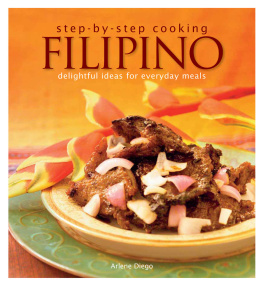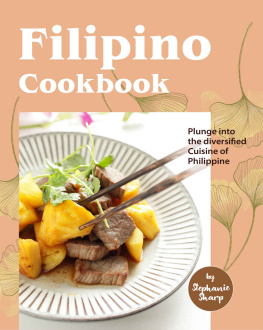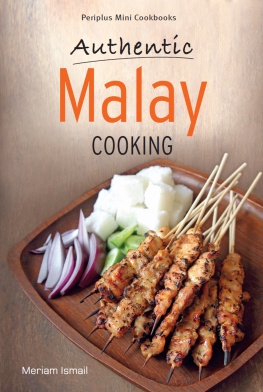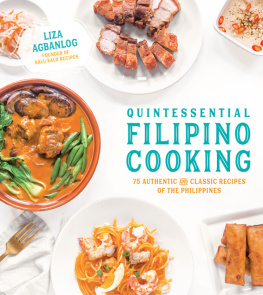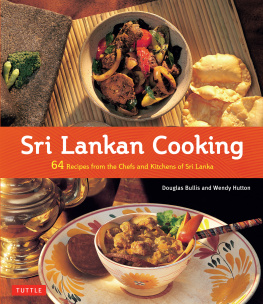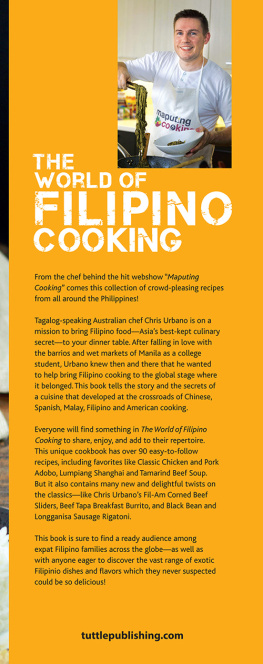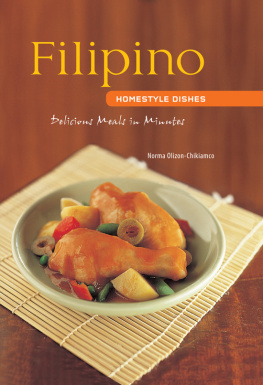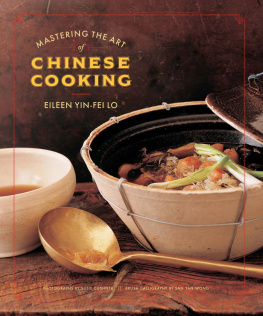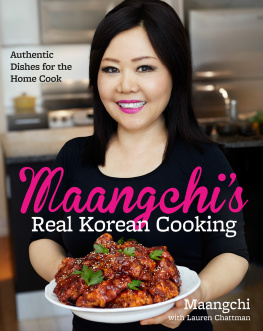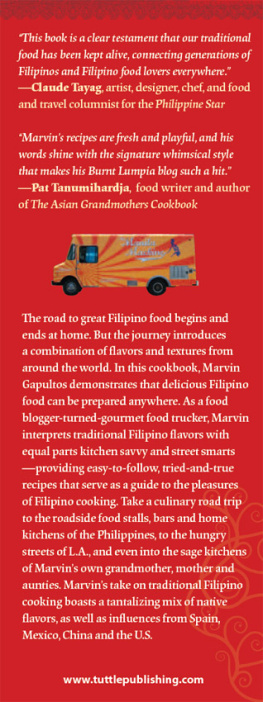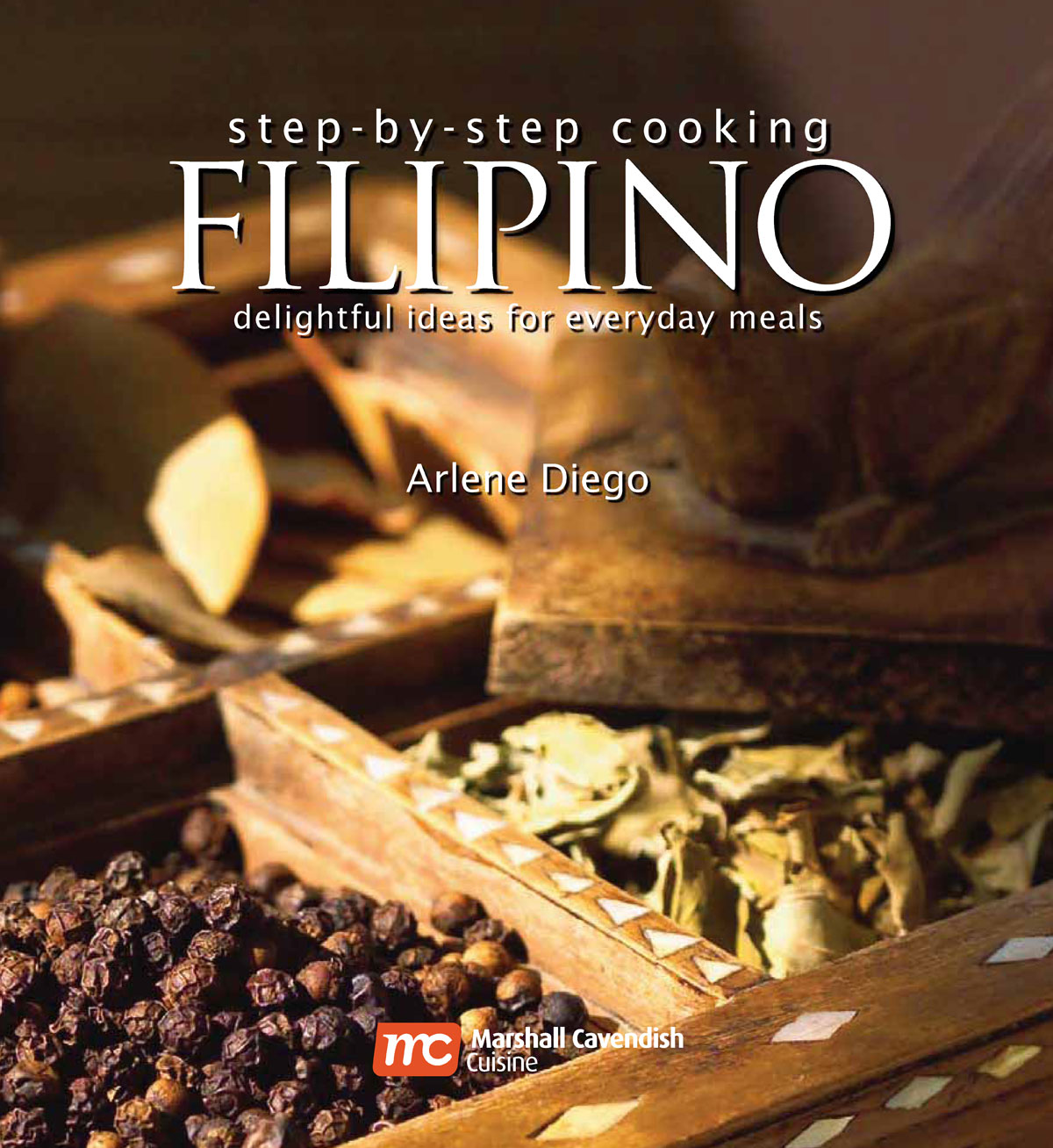step-by-step cooking
delightful ideas for everyday meals
This book is dedicated to my mother and father, with love and gratitude. Endless thanks to Janet
and all my friends who have supported me with their time and help for this project!
Arlene Diego
Photographer: Suan I Lim, Kamera Obscura
First published 2008 as Feast of Flavours from the Filipino Kitchen
This new edition 2009, reprinted 2011
Copyright 2008 Marshall Cavendish International (Asia) Private Limited
Published by Marshall Cavendish Cuisine
An imprint of Marshall Cavendish International
1 New Industrial Road, Singapore 536196
All rights reserved
No part of this publication may be reproduced, stored in a retrieval system or transmitted, in any
form or by any means, electronic, mechanical, photocopying, recording or otherwise, without the
prior permission of the copyright owner. Request for permission should be addressed to the Publisher,
Marshall Cavendish International (Asia) Private Limited, 1 New Industrial Road, Singapore 536196.
Tel: (65) 6213 9300, Fax: (65) 6285 4871 E-mail:
Online bookstore: http://www.marshallcavendish.com/genref
Limits of Liability/Disclaimer of Warranty: The Author and Publisher of this book have used their best
efforts in preparing this book. The Publisher makes no representation or warranties with respect to
the contents of this book and is not responsible for the outcome of any recipe in this book. While the
Publisher has reviewed each recipe carefully, the reader may not always achieve the results desired
due to variations in ingredients, cooking temperatures and individual cooking abilities. The Publisher
shall in no event be liable for any loss of profit or any other commercial damage, including but not
limited to special, incidental, consequential, or other damages.
Other Marshall Cavendish Offices:
Marshall Cavendish International. PO Box 65829 London EC1P 1NY, UK Marshall Cavendish
Corporation. 99 White Plains Road, Tarrytown NY 10591-9001, USA Marshall Cavendish International
(Thailand) Co Ltd. 253 Asoke, 12th Flr, Sukhumvit 21 Road, Klongtoey Nua, Wattana, Bangkok 10110,
Thailand Marshall Cavendish (Malaysia) Sdn Bhd, Times Subang, Lot 46, Subang Hi-Tech Industrial
Park, Batu Tiga, 40000 Shah Alam, Selangor Darul Ehsan, Malaysia
Marshall Cavendish is a trademark of Times Publishing Limited
National Library Board Singapore Cataloguing in Publication Data
Diego, Arlene.
Filipino : delightful ideas for everyday meals / Arlene Diego. New ed. Singapore : Marshall
Cavendish Cuisine, 2009.
p. cm. (Step-by-step cooking series)
Includes index.
eISBN-13 : 978 981 4435 15 4
1. Cookery, Philippine. I. Title. II. Series: Step-by-step cooking series (Marshall Cavendish Cuisine)
TX724.5
641.59599 -- dc22
OCN469342551
Printed in Singapore by Times Printers Pte Ltd
CONTENTS
Chicken Broth with Ginger and
Green Papaya (Tinola Manok)
Chicken and Young Coconut Soup
(Chicken Binakol)
Fish Soup with Ginger and Vegetables
(Pesa)
Taro Leaves in Spicy Coconut Milk
(Laing Na Gabi)
Stewed Vegetables with Prawn Paste
(Pinakbet Tagalog)
Stir-fried Glass Noodles (Sotanghon
Guisado)
Stir-fried Noodles with Sponge Gourd and
Prawns (Ginisang Patola At Misua)
Vegetable and Chicken Pot Pie
(Vegetable and Chicken Pastel)
Beef Steak with Onions and Potatoes
(Bistek)
Prawn Fritters with Sweet and Sour Sauce
(Camaron Rebosado)
Stewed Vegetables with Fish Broth
(Dinendeng)
Mexican Stew with Aubergine Sauce
(Puchero)
COOKING TECHNIQUES
Due to its rich history that was shaped by an influx of different cultures, Filipino cuisine is a blend of Western and Eastern cuisines. Therefore, it is only natural that Filipino food preparation and cooking techniques were adapted from the cuisines that shaped it into what it is today. The uniqueness of Filipino cooking does not lie in the techniques themselves, but in how they are employed to create the dishes.
GRILLING
The method of grilling is known as inihaw in Tagalog. This refers to food that is grilled (broiled) or barbecued over an open fire or hot coals. In the Philippines, eating places that specialise in grilled foods are known as ihaw-ihaw , or sinugba in the Visayan region. Meat, fish and seafood are always marinated before grilling, with seasonings such as the juice of a tangy, citric fruit like calamansi, fish sauce or various herbs and spices. It is useful to reserve any marinade, or to have a little cooking oil on the side to baste food items while grilling, as this helps to keep flavourful juices locked in. At home, grilling can also be done by cooking food in a grill pan or a regular convection oven.
BOILING AND SIMMERING
Boiling and simmering are both referred to as nilaga . They are two of the primary cooking methods in Filipino cuisine and are used in creating the one-pot meals that Filipino cuisine is famous for. Simmering should take place over medium to low heat, so that the liquid does not reach a constant boiling point, thus causing the liquid to evaporate completely and the food items to dry out and burn. Tough cuts of meat or hard vegetables
such as carrots and potatoes should always be simmered, as the constant temperature and gentle movement of the liquid help to ensure that the ingredients keep their shape as they are being cooked. Stews, in particular, should be simmered for the ingredients to cook in their own juices, thus retaining much flavour. Always refer to the recipe method to see if food should be simmered with the pot covered or uncovered, as this affects the flavour of the dish.
Another simmering method in Filipino cooking involves leaving food to cook in coconut milk, uncovered and with little or no stirring, until oil starts to separate and the coconut milk is thick and almost dry. This specific method of cooking is known as ginataan .
COOKING WITH VINEGAR
In Filipino cooking, there are 2 techniques for cooking with vinegar. The first, pinaksiw , involves food being cooked or stewed in vinegar without stirring. The second is kilawin , where food is cooked by immersing it in vinegar without using heat.
Pinaksiw involves adding vinegar to a combination of ingredients in a pot and bringing it to the boil without stirring. Stirring the mixture causes the vinegars sourness and acidity to increase. Sugar is usually added to counter the vinegar and prevent the dish from becoming too sour to consume. Kilawin is the technique used for preparing extremely fresh fish or seafood for a salad. The fish or seafood is immersed in a mixture of lemon juice, vinegar, chillies and ginger and left aside for 12 hours. Adding coconut milk is another variation of kilawin .

